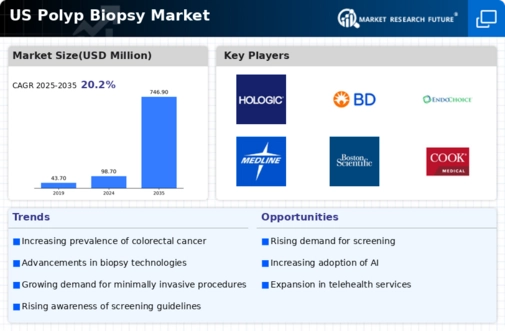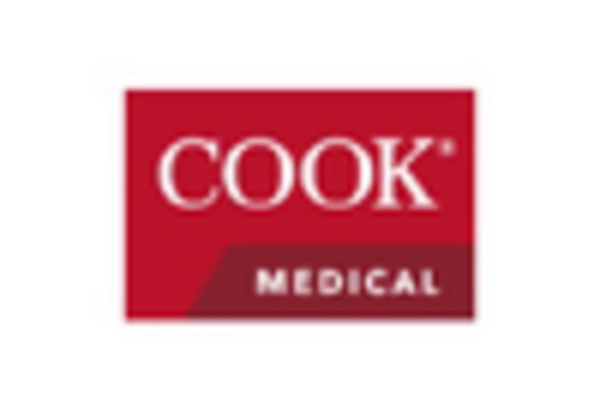Growing Geriatric Population
The aging population in the US is a significant driver of the polyp biopsy market. As individuals age, the risk of developing colorectal polyps and cancer increases, making regular screenings essential. The US Census Bureau projects that by 2030, all baby boomers will be over 65 years old, leading to a substantial rise in the geriatric population. This demographic shift is likely to result in a higher demand for polyp biopsy procedures, as older adults are encouraged to undergo routine screenings. The polyp biopsy market is expected to adapt to this growing need by enhancing services tailored to the elderly, including mobile screening units and specialized care. Additionally, healthcare policies promoting preventive care for seniors may further stimulate the market, ensuring that this vulnerable population receives timely and effective diagnostic services.
Increased Healthcare Expenditure
The rising healthcare expenditure in the US is a crucial factor propelling the polyp biopsy market. With healthcare spending projected to reach approximately $4.3 trillion by 2025, there is a growing investment in diagnostic services, including polyp biopsies. This increase in funding allows for the adoption of advanced technologies and improved healthcare infrastructure, facilitating better access to screening and diagnostic procedures. As patients become more willing to invest in their health, the demand for polyp biopsy services is expected to rise. The polyp biopsy market stands to benefit from this trend, as healthcare providers expand their offerings to meet the needs of a more health-conscious population. Furthermore, insurance coverage for preventive services is likely to enhance patient access to polyp biopsies, further driving market growth.
Advancements in Biopsy Techniques
Innovations in biopsy techniques are significantly influencing the polyp biopsy market. The introduction of minimally invasive procedures, such as endoscopic mucosal resection (EMR) and endoscopic submucosal dissection (ESD), has improved the accuracy and safety of polyp biopsies. These advancements allow for the removal and analysis of polyps with reduced patient discomfort and shorter recovery times. As a result, healthcare providers are increasingly adopting these techniques, which may lead to a surge in the number of procedures performed. The polyp biopsy market is likely to see a shift towards these advanced methodologies, as they not only enhance diagnostic capabilities but also improve patient outcomes. Additionally, the integration of imaging technologies, such as narrow-band imaging (NBI), further supports the growth of the market by enabling better visualization of polyps during procedures.
Rising Incidence of Colorectal Cancer
The increasing incidence of colorectal cancer in the US is a primary driver for the polyp biopsy market. According to the American Cancer Society, colorectal cancer is the third most common cancer, with an estimated 104,270 new cases expected in 2023. This alarming trend necessitates enhanced screening and diagnostic measures, including polyp biopsies, to detect precancerous lesions early. As healthcare providers emphasize early detection, the demand for polyp biopsy procedures is likely to rise. Furthermore, the polyp biopsy market is expected to benefit from increased funding for cancer research and awareness campaigns aimed at educating the public about the importance of regular screenings. This growing focus on colorectal health may lead to a more proactive approach in managing and preventing colorectal cancer, thereby driving market growth.
Enhanced Awareness and Education Initiatives
Enhanced awareness and education initiatives regarding colorectal health are playing a pivotal role in the growth of the polyp biopsy market. Various organizations, including the American Cancer Society, are actively promoting awareness campaigns aimed at educating the public about the importance of early detection and screening for colorectal cancer. These initiatives are likely to lead to increased screening rates, as individuals become more informed about the risks associated with colorectal polyps. The polyp biopsy market is expected to benefit from this heightened awareness, as more patients seek out diagnostic services. Furthermore, educational programs targeting healthcare providers may improve the quality of care and increase the number of polyp biopsies performed, ultimately contributing to market expansion.

















Leave a Comment